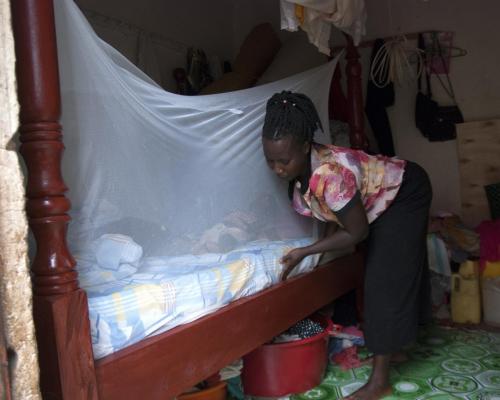
Kampala – A month after Uganda instituted stringent measures to curb the spread of COVID-19, the threat of another disease outbreak prompted a new nationwide campaign: “Why survive COVID-19 and die of malaria?” rang a slogan on the airwaves.
Uganda confirmed its first case of the virus in late March, coinciding with the start of the rainy season when malaria infections surge. With curfews and lockdowns limiting movement, and fear of visiting health facilities and a strained health workforce cutting back consultations, health authorities launched the drive to shore up malaria prevention and treatment.
Malaria is the leading cause of death in Uganda. In 2019, it claimed 4000 lives and infected more than 13 million people. With the movement restrictions, malaria infections were projected to increase by 22% and the number of deaths to double, says Dr Jimmy Opigo, the Assistant Commissioner for Health Services at the Ministry of Health, citing a WHO and Lancet study.
Hospital admissions for malaria dropped: 47 775 admissions were recorded in May compared with 68 856 in May 2019. “So our main advocacy message was that both diseases were to be fought together,” Dr Opigo explains.
The supply of critical material for malaria control also suffered disruptions. The production lines of many biomedical firms shifted towards COVID-19 supplies, slowing down the manufacture and distribution of materials such as rapid test kits for malaria, says Dr Bayo Fatunmbi, who heads the disease prevention and control team at the World Health Organization (WHO) office in Uganda.
The essentials
Providing critical health services while battling the pandemic implies designating the essential services and reorienting the health system components to maintain the services. Under the COVID-19 response, the government set up a unit charged with steering the maintenance of essential services. Working with WHO and other partners, the government issued guidance and trained health workers at the national and district levels on how to ensure key services, including malaria, were provided safely.
The health workforce was redistributed, re-assigned and tasks shared according to the most urgent needs. “To ensure that no malaria cases are missed, we emphasized the need to test all patients complaining of fever at screening posts and treatment centres,” says Dr Opigo.
Health workers involved in insecticide-treated bed net distribution were trained on how to undertake the task safely without exposing themselves or the recipients to risks of COVID-19 infection, Dr Fatunmbi explains. Yet as the need for bed net distribution grew, floods complicated movement as more than half of the country’s 134 districts were affected by the deluge.
Adopting to COVID-19 prevention measures, the bed net distribution went partly digital, with recipients registered through a mobile phone-based app and small teams deployed to deliver the nets from house-to-house. Local radio stations aired programmes to raise public’s awareness on the new procedures. Ordinarily, the nets are distributed in public gatherings – an impossible option given the pandemic.
Out of 29 million bed nets meant to be distributed as from early 2020, more than 19 million have so far been given to households. Another 6 million will be distributed in December and 4 million in February 2021.
“It is the best way to prevent malaria because mosquitos can’t bite us. Nobody in my family has had malaria in a long time,” says Betty Nabokenya, a resident of Mpigi district on the shores of Lake Victoria, where more than 86 000 nets were recently distributed.
As restrictions were being eased gradually from early May, indoor residual spraying also resumed, with a trained workforce in 16 high burden districts in central Uganda protecting about 5 million people.
“COVID paralysed our system but we are now beginning to normalize the situation and work despite COVID,” says Edward Ssemwanga, a senior vector control officer in Mpigi district.
Dr Fatunmbi of the WHO notes that the promotion of access to malaria prevention and treatment services helped to contain an upsurge in malaria infections in 2020 despite the massive floods.
“We are not out of the woods yet in relations to COVID-19 disruptions,” he warns “Health worker infection remains a major threat. Shortage of PPEs [personal protective equipment] for health workers at all levels must be addressed. However, the malaria community is on the alert to address the risks and avert threats.”











Comments